By Bryan Pfeiffer and Kent McFarland
The warblers have left us for the warmth. Butterflies are but a fond memory. Amphibians are holed up for winter. And Vermont’s deer-hunting season has begun. But do not fret this quiet, leafless time. Here’s a quick field guide to “Stick Season.”
Zombie Aspen Leaves
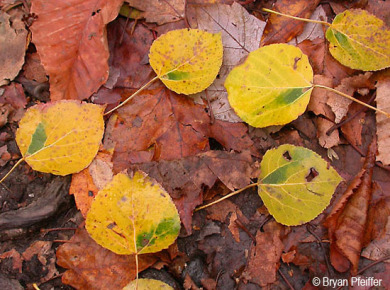 Yellow and brown and down to earth, they might appear dead. But they are not quite dead. They are the undead: zombie aspen leaves.
Yellow and brown and down to earth, they might appear dead. But they are not quite dead. They are the undead: zombie aspen leaves.
Find them as you walk the brown autumn paths – yellow leaves with a patch of green tissue radiating from the base of the midrib. Here in Vermont, these are mostly Quaking Aspen (Populus tremuloides), but we also find the green on Big-toothed Aspen (P. grandidentata) and, rarely, Eastern Cottonwood (P. deltoides). So what’s the cause here?
Bryan explains the mystery in these leaves on his blog.
A Wingless Winter Moth
In the angled daylight of November, a moth is crossing our paths in barren woods. Yeah, a moth … in the cold. By now virtually all our moths and butterflies should no longer live as gossamer-winged adults. Instead, they’re overwintering as either eggs, caterpillars, or pupae (a cocoon in the case of a moth). But as you walk through deciduous woods in November and even into December, look for an exception – a lesson in adaptation, fertility, and feminine sacrifice going by the name Bruce Spanworm. These moths are also called Hunter’s Moths because they fly in the company of deer hunters.
As a caterpillar, Bruce Spanworm (Operophtera bruceata) is one of the inchworms, a member of the large moth family called Geometridae (which means “earth-measuring”). As an adult, Bruce Spanworm is not particularly showy. Its forewings, about 1.5 inches across, are dull gray with dark flecking, and its hindwings are even less dramatic. But who needs pizzazz when you’ve got the audacity to fly around in winter? Kent explains how it happens on his blog and Bryan also offers a perspective on his blog.
The Last Dragonfly
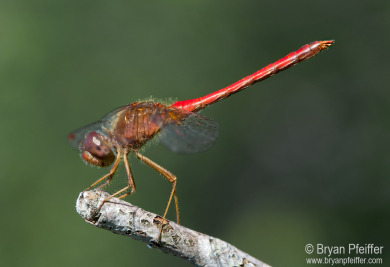 We don’t call it Autumn Meadowhawk for nothing. Find it this autumn in your local meadow hawking for insects. One of about 140 dragonfly and damselfly species in Vermont, this one begins its flight season in July. Our latest flight date on record is November 26. Vermont has five of these red meadow hawk species (in the genus Sympetrum), only one of which, this one, has yellow legs and is most likely the last adult dragonfly you’ll see until April (unless you head south this winter). Look for it drifting past fall hawkwatch sites or baking in what little sun and warmth is available in various open habitats late in the year.
We don’t call it Autumn Meadowhawk for nothing. Find it this autumn in your local meadow hawking for insects. One of about 140 dragonfly and damselfly species in Vermont, this one begins its flight season in July. Our latest flight date on record is November 26. Vermont has five of these red meadow hawk species (in the genus Sympetrum), only one of which, this one, has yellow legs and is most likely the last adult dragonfly you’ll see until April (unless you head south this winter). Look for it drifting past fall hawkwatch sites or baking in what little sun and warmth is available in various open habitats late in the year.
The Butcher Bird Arrives
No, not the turkey on your platter. We’re talking about Northern Shrikes, aka “butcher bird” – a predatory songbird that breeds in the far north and winters in southern Canada and the northern United States. Shrikes feed on small birds, mammals, and insects, and are known for impaling them on spines or barbed wire fences. VCE’s Chris Rimmer discovered that they can return winter after winter to the same territory. Using band recoveries, he found 12 cases in which shrikes were recaptured at or near the same winter location one to three years later. Keep a look out for these feisty songbirds and be sure to report your sightings to eBird.
“Blue Fuzzy-Butts”
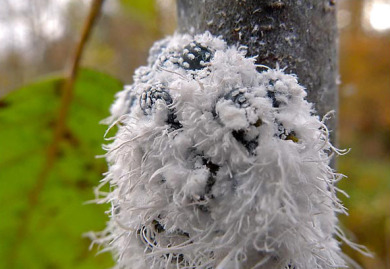 Those tiny tufts of powder-blue lint floating, well, like floaters in your field of view, aren’t outcasts from the dryer cycle. They’re hearty November insects, the adult form of a wooly aphid species. We more often see these aphids gathered in a mass on speckled alder, sucking liquids and covered with a waxy white coating resembling cotton or wool (like the image here). But the adult stage (the blue-lint form) is now on the wing. Bryan’s partner Ruth calls them “Blue Fuzzy-Butts.” Bryan is having a heck of a time getting a decent photo. So here’s an image from the web site Dave’s Garden. And these insects are not to be confused with Fuzzy Butt Farm, which offers dressage lessons in Fernley, Nevada, or, for that matter, Fuzzy Butt Spa, which offers doggy day-care in Boothwyn, Pennsylvania.
Those tiny tufts of powder-blue lint floating, well, like floaters in your field of view, aren’t outcasts from the dryer cycle. They’re hearty November insects, the adult form of a wooly aphid species. We more often see these aphids gathered in a mass on speckled alder, sucking liquids and covered with a waxy white coating resembling cotton or wool (like the image here). But the adult stage (the blue-lint form) is now on the wing. Bryan’s partner Ruth calls them “Blue Fuzzy-Butts.” Bryan is having a heck of a time getting a decent photo. So here’s an image from the web site Dave’s Garden. And these insects are not to be confused with Fuzzy Butt Farm, which offers dressage lessons in Fernley, Nevada, or, for that matter, Fuzzy Butt Spa, which offers doggy day-care in Boothwyn, Pennsylvania.
The Snow Goose Scoop
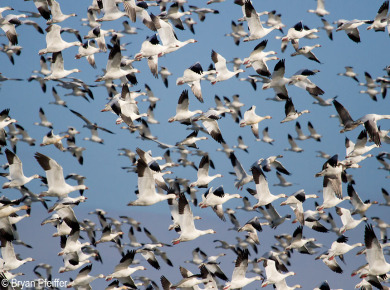 This past week or two offered some of the season’s best views of Snow Geese gathered at Dead Creek Wildlife Management Area in Addison, Vermont. Birders reported somewhere between 6,000 and 7,000 geese, according to Glen Chretien, who was visiting from Cape Cod in mid November. At one point the goose flock stretched from the viewing area on Route 17 southward for a mile to Gage Road.
This past week or two offered some of the season’s best views of Snow Geese gathered at Dead Creek Wildlife Management Area in Addison, Vermont. Birders reported somewhere between 6,000 and 7,000 geese, according to Glen Chretien, who was visiting from Cape Cod in mid November. At one point the goose flock stretched from the viewing area on Route 17 southward for a mile to Gage Road.
Although we don’t see the huge flocks of geese in Vermont anymore, the birds remain well into November. You can get updates on the fall migration from Bryan Pfeiffer.
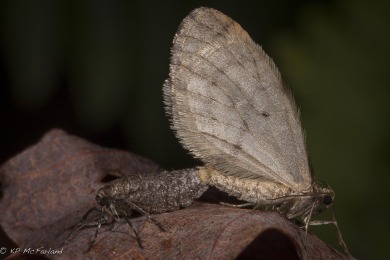
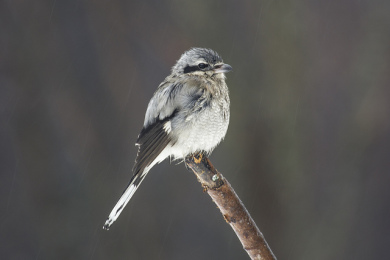

I love the new look!